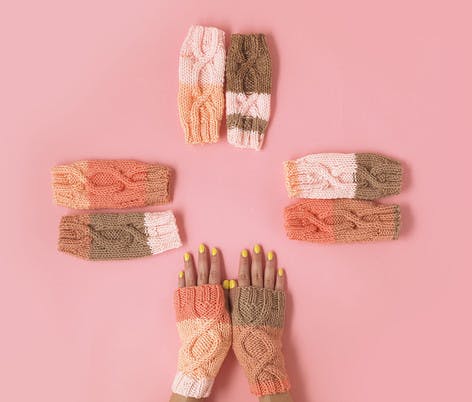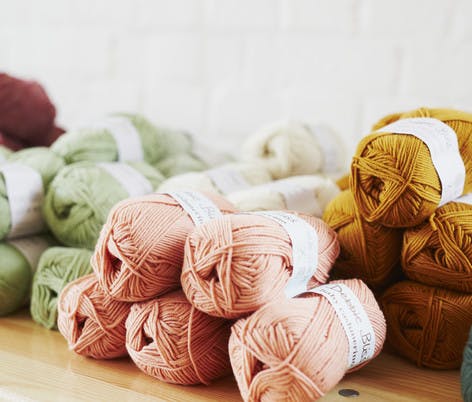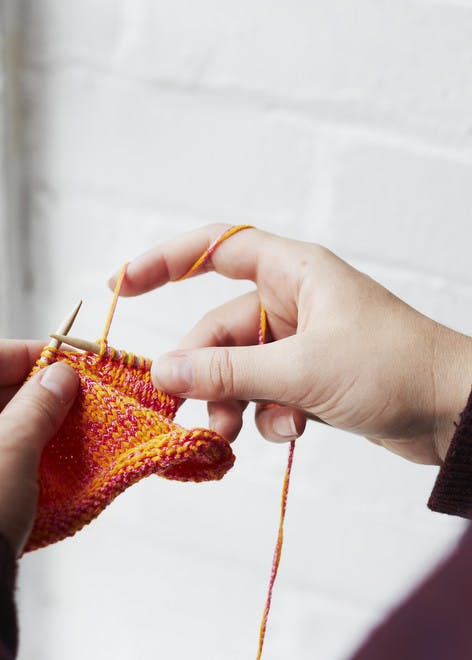How to add length to your knitting
Published on 28 January 2019 By Elizabeth Bagwell 4 min read
Kids shoot up quickly and many a proud knitter has discovered that a favourite sweater still fits fine across the shoulders but has turned into a cropped top. Don’t abandon it yet! If you’ve got a lovely top with sleeves that are too short, a hat with a brim that ends mid-scalp or a scarf suitable for a doll, these tips will show you how to add on knitting to the pieces you love. You can even add length to a sweater with material you can knit up yourself! It may help you salvage your creation so you can love it for many more years to come.
Rip back your knitting
Ripping back your knitting is usually the easiest option, but we know this can be a scary and sometimes downright impossible task. If you can't bear the idea of unravelling your hard-worked knitting, then don't fret, as there we have plenty more less destructive methods to try!
Add more colour
If you’re running out of yarn, adding a stripe or a colourwork panel just above the rib will typically look better than simple switching colours exactly when you run out. This is because finishing with the shade you started with makes it look like the stripe is a deliberate design choice, rather than a necessary invention.


Cut the rib off and keep knitting
If you cut the hem off, you can pick up the live stitches and add some extra length. Unpick the seams (if necessary) first, so you’ve got a clear canvas to work on.
Snip a single stitch a row or two above the rib. Unravel it along the row and pick up the live stitches from both body and rib on separate needles. This works whether you knit the piece top down or bottom up. Knit until the jumper is long enough, then use kitchener stitch to graft the original ribbing back on.
If the jumper has been washed repeatedly, even yarn from the original dye lot may look like a different shade so it’s a good idea to make a conscious choice to add a stripe here.

Knit in garter stitch
Some stitches use more yarn than others, but there are lots of options when planning how to add on knitting to your garment. Garter stitch, for example, tends to have more rows to the inch than stocking stitch so uses more yarn. Fair isle colourwork, with its floats, will use more yarn than stripes. If you want to learn how to add length to a sweater knitting project this is a great technique to use!
If you’re running out of yarn towards the end of a project, consider adding a band of lace. While crochet often uses more yarn than knitting, a delicate crochet band can cover a lot of ground with a little bit of thread. Of course, the end result will be see-through, which may not be appropriate depending on what you're knitting.
Crochet an extra panel
As crochet effectively works on a cast off edge every row, you don’t even need to unravel the edging to add a crochet border to your project. The two crafts have quite different textures and properties, even in the same yarn, so it’s a good idea to make a swatch to ensure you like the edging you’ve chosen as a fabric before you start.
Don’t expect to pick up a crochet stitch for every knit stitch, even if you are using the same yarn, as very few people will have the same tension across both crafts. Remember that crochet is typically much less stretchy than knitting so if you want a stretchy rib, use knitting. Crochet often uses more yarn than knitting so calculate accordingly.
Add a fabric panel
Adding to a knitted piece doesn't have to be more knitted stitches! Learn how to add length to a sweater with material, by attaching a fabric panel to give your garment length can be very easy to do. Use a fabric that has similar properties to the knitting in texture and stretch, or something that will compliment or enhance your work. This option is a great way to solve multiple problems with a project at once. For example, if you’ve knitted a handbag that’s not only too small but also too floppy for you to want to use, a solid canvas lining can make the bag taller and stronger.